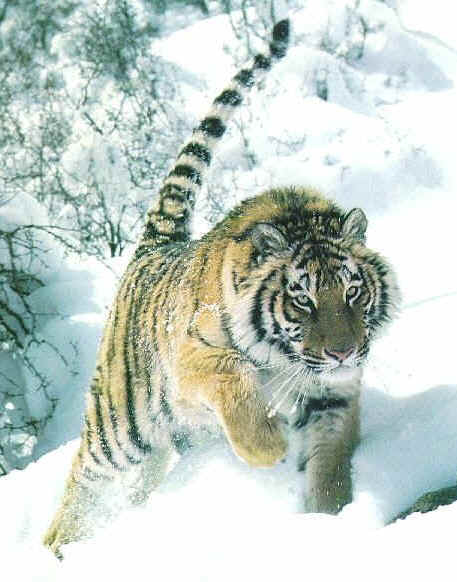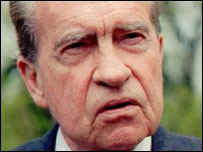 TigerSoft News Service 3/19/2008
Visit our www.tigersoft.com
TigerSoft News Service 3/19/2008
Visit our www.tigersoft.com
LONG WARS ARE ALSO DEADLY
FOR THE STOCK MARKET.
More Hidden Shockers Are Coming out about Nixon's Secret Wars in SE Asia. See below.
Isn't five years enough?
How can America fight a successful war with 31% support in the US
and 80% opposition in Iraq to an American occupation? What a disgrace!
Shame on Bush, Cheney and Nancy Pelosi! I have talked about this
frequently.
http://www.tigersoftware.com/TigerBlogs/3-07-2008/index.html
http://www.tigersoft.com/Tiger-Blogs/8-4-2007/index.htm
http://www.tigersoft.com/Tiger-Blogs/7-27-2007/index.htm
http://www.tigersoft.com/Tiger-Blogs/7-12-2007/index.htm
http://www.tigersoft.com/Tiger-Blogs/6-14-2007/index.htm
The FED can only give 1-2 day boosts to the stock market by making
record-sized cuts in the Discount Rate and offering elite banks billions
in loans for collateral which is suspect. It is the bloody, hugely expensive war
which is hurting the stock market. I have said this over and over here.
CNN, NBC, ABC and CNBC seem utterly unable to draw the line between the
dots. I did notice that C-Span had economic professors Spiglitz and Bilmes
present their book, The Three Trillon Dollar War.
Demonstrations against unpopular wars are a right of every American.
They are inevitable. An unpopular war necessarily hurts the stock market.
The market can survive a popular war like WWII or even the Korean
War. It had a much harder time dealing with World War I and a terrible
time coping with the War in Viet Nam. Bush's War on Iraq is no different.
by William Schmidt, Ph.D. (Columbia University)
(C) 2008 All rights reserved. Reproducing any part of this page without
giving full acknowledgement is a copyright infringement.
 |
Tiger
Software Helping Investors
|
SHAME ON GEORGE BUSH, CHENEY AND NANCY PELOSI
It was not hard to understand that starting a war in Iraq would be a horrible tragedy.
From from the length of the US War in Viet Nam, I learned that such wars seem to have
to be stopped in the streets by demonstrating Americans. Soul-less politicians have no
problem letting the war go on and on. It took a soldier who knew war to bring the Korean
war to an end The Iraq war fiasco would seem to show that "chicken-hawks" are too
quick to start a war and too slow to admit they have made a deadly stupid and deadly
costly blunder.

============================ 1917 ===================================

============================ 1918
===================================

---------------------------------------- 1969
----------------------------------------------------------

Nixon Risked Nuclear War in 1969
The excerpts below come from http://www.wired.com/politics/security/magazine/16-03/ff_nuclearwar
"During his campaign for the presidency
the year before, Richard Nixon had vowed to end that conflict.
But more than 4,500 Americans had died there in the first six months of 1969, including 84
soldiers at the debacle
of Hamburger Hill. Meanwhile, the peace negotiations in Paris, which many people hoped
would end the conflict,
had broken down. The Vietnamese had declared that they would just sit there, conceding
nothing, "until the chairs rot."
Frustrated, Nixon decided to try something new: threaten the Soviet Union with a massive
nuclear strike and make its
leaders think he was crazy enough to go through with it. His hope was that the Soviets
would be so frightened of events
spinning out of control that they would strong-arm Hanoi, telling the North Vietnamese to
start making concessions
at the negotiating table or risk losing Soviet military support."
"Codenamed Giant Lance, Nixon's plan was the culmination of
a strategy of premeditated madness he had developed
with national security adviser Henry Kissinger. The details of this episode remained
secret for 35 years and have never
been fully told. Now, thanks to documents released through the Freedom of Information Act,
it's clear that Giant Lance
was the leading example of what historians came to call the "madman theory":
Nixon's notion that faked, finger-on-the-button
rage could bring the Soviets to heel.
"Nixon and Kissinger put the plan in motion on October 10, sending
the US military's Strategic Air Command an
urgent order to prepare for a possible confrontation: They wanted the most powerful
thermonuclear weapons in the
US arsenal readied for immediate use against the Soviet Union. The mission was so
secretive that even senior military
officers following the orders — including the SAC commander himself — were not
informed of its true purpose....
"On the morning of October 27, 1969, a squadron of 18
B-52s — massive bombers with eight turbo engines and
185-foot wingspans — began racing from the western US toward the eastern border of
the Soviet Union. The pilots
flew for 18 hours without rest, hurtling toward their targets at more than 500 miles per
hour. Each plane was loaded
with nuclear weapons hundreds of times more powerful than the ones that had obliterated
Hiroshima and Nagasaki.
The B-52s, known as Stratofortresses, slowed only once, along the coast of Canada near the
polar ice cap. Here,
KC-135 planes — essentially 707s filled with jet fuel — carefully approached the
bombers. They inched into place
for a delicate in-flight connection, transferring thousands of gallons from aircraft to
aircraft through a long, thin tube.
One unfortunate shift in the wind, or twitch of the controls, and a plane filled with up
to 150 tons of fuel could crash
into a plane filled with nuclear ordnance. The aircraft were pointed toward Moscow, but
the real goal was to change
the war in Vietnam.
"After their launch, the B-52s pressed against Soviet airspace for
three days. They skirted enemy territory, challenging
defenses and taunting Soviet aircraft. The pilots remained on alert, prepared to drop
their bombs if ordered. The Soviets
likely knew about the threat as it was unfolding: Their radar picked up the planes early
in their flight paths, and their
spies monitored American bases. They knew the bombers were armed with nuclear weapons,
because they could
determine their weight from takeoff patterns and fuel use. In past years, the US had kept
nuclear-armed planes in the air
as a possible deterrent (if the Soviets blew up all of our air bases in a surprise attack,
we'd still be able to respond).
But in 1968, the Pentagon publicly banned that practice — so the Soviets wouldn't
have thought the 18 planes were
part of a patrol. Secretary of defense Melvin Laird, who opposed the operation, worried
that the Soviets would
either interpret Giant Lance as an attack, causing catastrophe, or as a bluff, making
Washington look weak".
This story continues at http://www.wired.com/politics/security/magazine/16-03/ff_nuclearwar?currentPage=2
People discover that Nixon's peace plan was intensifying the bombing of Hanoi.

--------------------------------------- 1970
----------------------------------------------------------
Nixon expanded war into Laos and
Cambodia, completely violating the international rights of these
countries. It tried to keep these secret campaigns. The intense bombing
campaigns and intervention in
Cambodia in late April 1970 sparked intense campus protests all across America. At Kent
State in Ohio,
four students were killed by National Guardsmen. Several were not even in the
student protects but
were drawn by the crowds. Shock waves crossed the nation as students at Jackson State in Mississippi
were also shot and killed by police as they demonstrated against the war.
Here is a Sampling Of Anti-War Songs
I remember
hearing then.


From http://news.bbc.co.uk/2/hi/americas/4444638.stm
Nixon ordered Cambodia cover-up (BBC report)
1970
"Richard Nixon told top aides involved in Vietnam to lie to the public about US
operations in neighbouring Cambodia,
files
released in Washington show. He ordered the deception at a meeting
of his top military and national security aides
in
1970, a month after admitting publicly to a secret war. "Publicly, we say one thing -
actually, we do another," the president
said
in a memo after the meeting. About 14,000 US troops were in Cambodia hunting North
Vietnamese forces.
Nixon's revelation of the operation sparked protests and congressional action over what
many US lawmakers viewed
as an
illegal war. When he called the security meeting at his Western White House in
California on 31 May, it was to tell his
aides
to carry on without regard to public opinion at home. "I want you to put
the air in there and not spare the horses
- do not withdraw for domestic reasons but only for military reasons," the files
released by the US National Archives show
him as saying. "Just do it. Don't come back and
ask permission each time." "We cannot sit here and let the enemy believe
that Cambodia is our last gasp," he argued in the memo, marked as "Eyes Only, Top Secret Sensitive". Nixon
noted that
Americans already believed the Cambodian operation was "all but
over". He also ordered plans for offensive operations
in neutral Laos and a summer offensive in South Vietnam.
On April 30th, 1970,
Nixon publicly admitted the expansion of the war in Viet Nam to Laos and Cambodia.

Anti War Protests in Washington often led to market weakness.
- November 15, 1969 - National
Mobilization to End the War. Vietnam Moratorium.
600,000 demonstrate against the war in Vietnam. - May 9, 1970 - Kent
State/Cambodia Incursion Protest. A week after the Kent
State shootings,
a 100,000 demonstrators converged on Washington to protest the shootings and President Richard Nixon's
incursion into Cambodia. - April 19, 1971 - Operation Dewey Canyon
Three by the Vietnam Veterans against the War. Over 2,000
veterans camp on the Mall, protest all over the city. John Kerry testifies in front of Senate. - April 24, 1971 - Vietnam War Out Now rally. 500,000 call for end to Vietnam War.
- May 3, 1971 - 1971
May Day Protests. Mass action by Vietnam anti-war militants to shut down the
federal government. - January 20, 1973, Anti-war protest
demonstration. Includes the Yippie-Zippie RAT float & SDS
"March Against Racism & the War" contingent.
-------------------------------------- 1973 ----------------------------------------------------------
The extent of Nixon's secret war in Cambodia and Laos was not discovered by Congress until
July 1973.

------------------------------------- 1974 ----------------------------------------------------------


http://img.dailymail.co.uk/i/pix/2007/08_03/004VietnamWar_468x382.jpg
More information and pictures from http://vietnamwar.cloudworth.com/death-horror.php
Vietnam War News
War, battles, memorabilia
· Battles & Soldiers
· Special Forces
· Helicopthers
· Antiwar movement
· Films, Movies & Documentaries
· Agent Orange
· TET Offensive
Aftermath & Battlefields today
· MIA: Remains of Soldiers
· Vietnam Today
· Women & Wartime
· Re-enactment
Vietnam War Misc
· Memorabilia: Militaria, Medals &
Decorated Heroes
· Art & Propaganda
· CIA: Spies & Intelligence
· Wartime Stories
· Hmong: Guerilla resistance
· POWs
· Death & Horror
,